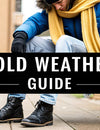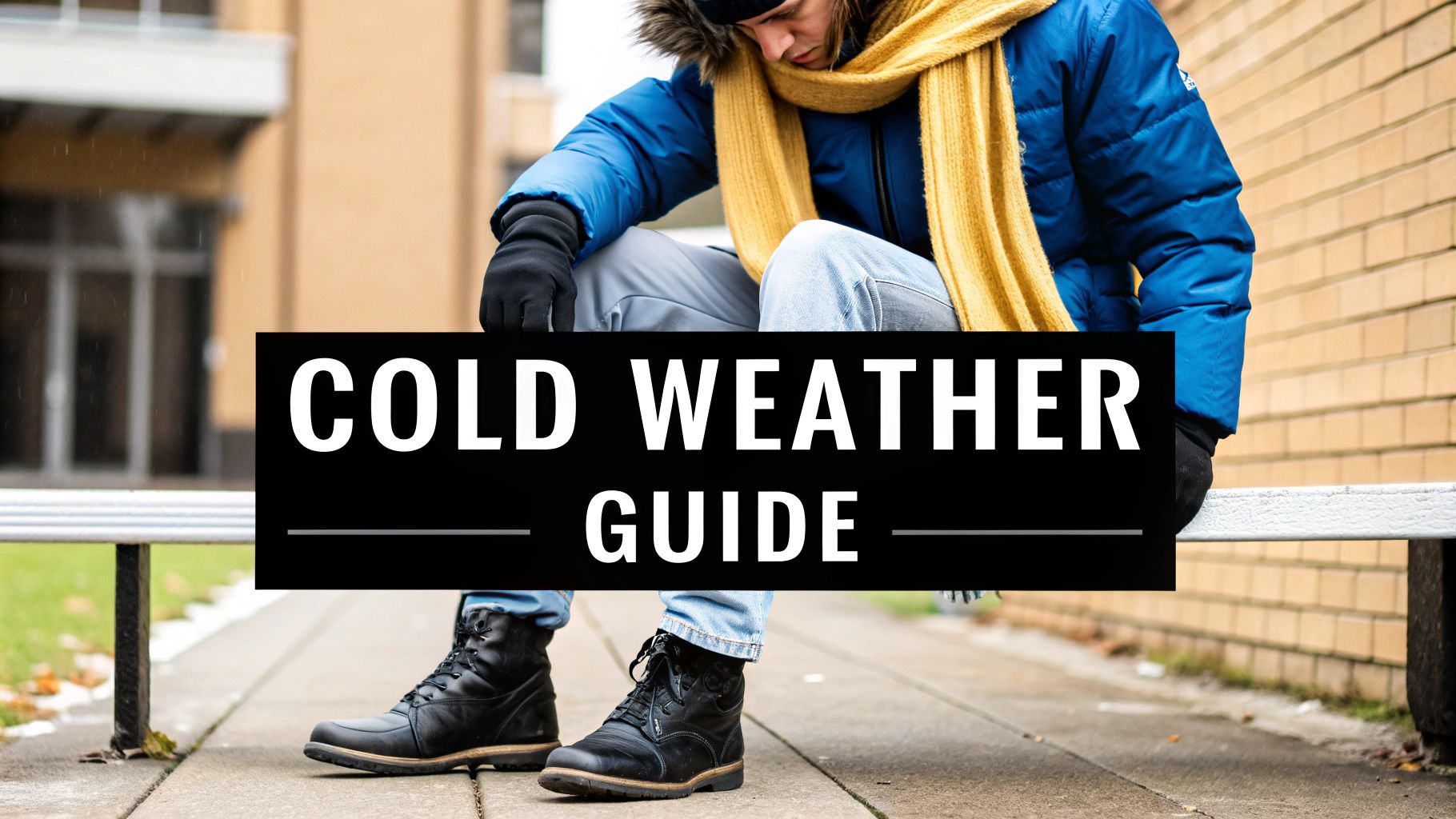
Forget the idea that one giant, bulky coat is the answer to staying warm. The real secret, something those of us who spend a lot of time outdoors swear by, is a smart layering system. It’s all about combining a moisture-wicking base layer, an insulating mid-layer, and a protective outer layer. This simple trio works together to trap heat, keep you dry, and let you adapt on the fly.
Why Layering Is Your Secret Weapon
We’ve all made the mistake of just throwing on a heavy jacket. You feel toasty for a minute, but as soon as you start moving, you overheat and start to sweat. That moisture gets trapped, and the second you slow down, you're hit with a bone-chilling cold. That’s a fast track to being miserable.
The art of dressing for the cold is really about creating your own personal climate control system.
The magic is in the air. By wearing several thinner layers, you create pockets of air between them. Air is a fantastic insulator, so these trapped pockets hold onto your body heat, keeping you much warmer than a single thick garment ever could. Each piece has a specific job to do:
- The Base Layer: This is what’s right against your skin. Its only job is to pull sweat away from your body so you stay dry.
- The Mid-Layer: This is your powerhouse for warmth. It’s the insulation that traps your body heat. Think fleece, down, or a good synthetic puffy jacket.
- The Outer Layer: Consider this your shield. It blocks wind, rain, and snow, making sure your other two layers can do their jobs effectively.
Understanding The Three-Layer System
The whole system falls apart if one layer isn't doing its part. Think about it in a real-world scenario: you're heading out for a brisk autumn hike. Your merino wool base layer is pulling sweat away as you tackle an incline. Your fleece mid-layer is holding in all that precious body heat. And your windbreaker outer layer is stopping that biting wind from cutting right through you.
This simple infographic gives you a great visual of how the pieces come together.
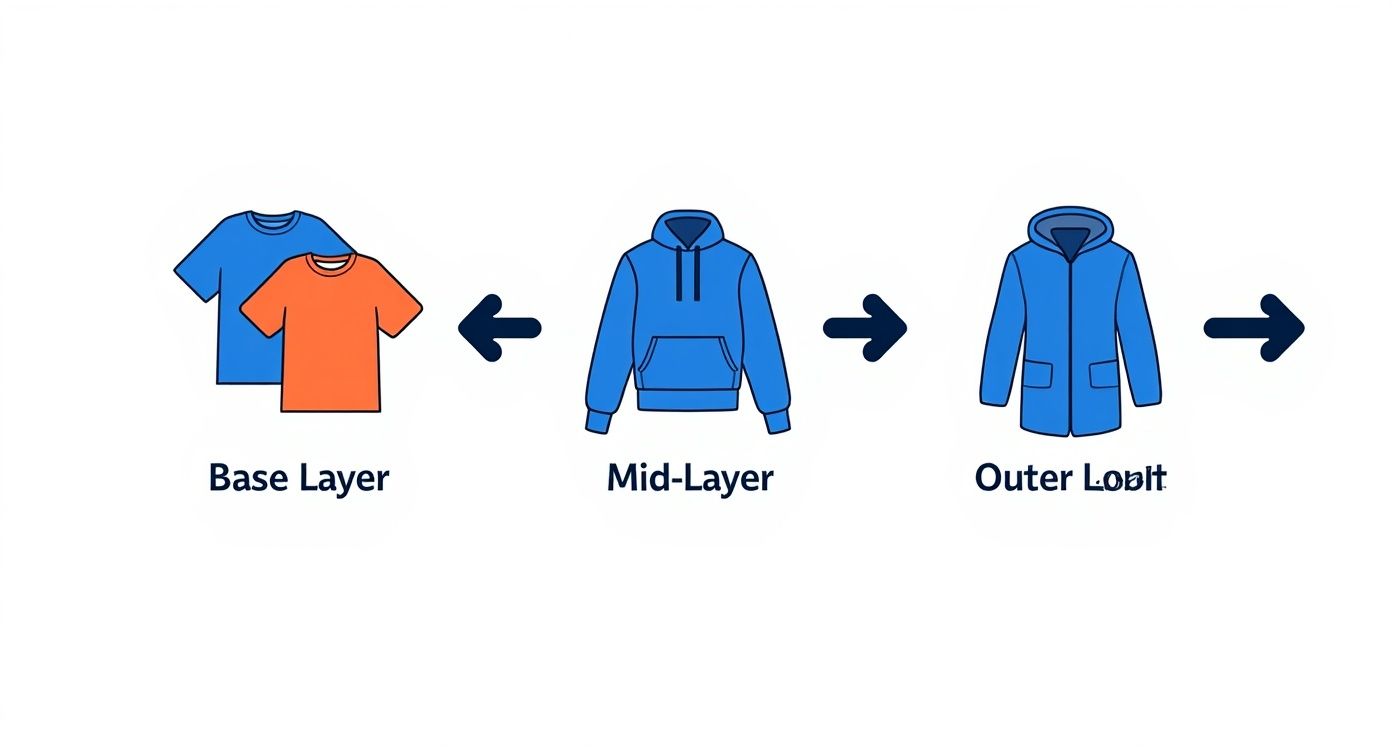
When you get the hang of it, you'll feel ready for anything. It’s all about mastering a few key principles. For a more detailed look, our guide on how to layer clothes effectively has some great tips.
To make it even easier, here's a quick cheat sheet for the three-layer system.
Your Quick Guide to the Three-Layer System
| Layer | Primary Role | Best Materials |
|---|---|---|
| Base | Wicks moisture away from skin | Merino wool, silk, synthetic fabrics (polyester) |
| Mid | Insulates by trapping body heat | Fleece, down, wool, synthetic puff |
| Outer | Protects from wind, rain, and snow | Waterproof/windproof shells (Gore-Tex) |
Keep this in mind, and you’ll be building effective, comfortable outfits in no time.
The Growing Importance of Quality Gear
It's not just you—more people are getting outside and realizing the value of good gear. The market for extreme cold weather clothing was valued at around $15 billion in 2025 and is expected to climb to $25 billion by 2033. This boom is driving incredible innovation in fabrics and design, giving us better, lighter, and warmer options than ever before.
The biggest advantage of layering is adaptability. As conditions change or your body temperature fluctuates, you can easily add or remove a layer to stay perfectly comfortable without having to change your entire outfit.
This modular approach is what makes layering so brilliant. You’re ready for anything, whether it's a chilly morning dog walk that turns into a sunny afternoon or a mountain hike with unpredictable weather.
Picking the Right Fabrics to Actually Keep You Warm
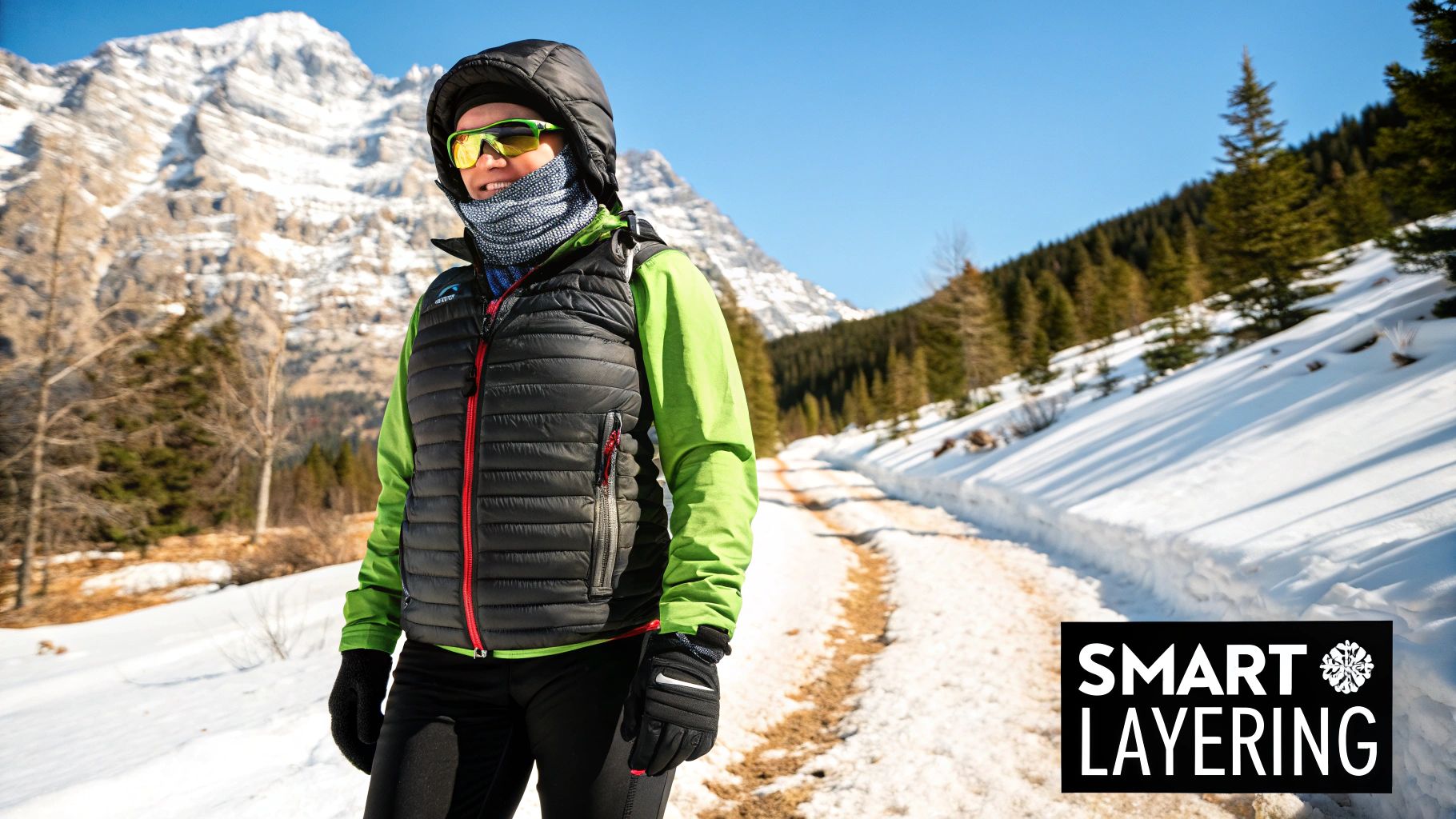
You can have the most sophisticated layering strategy in the world, but it all falls apart if you're using the wrong materials. Honestly, your fabric choice is where the real battle against the cold is won or lost. Different textiles behave in wildly different ways, especially when it comes to holding onto heat and dealing with sweat.
Think of each fabric as a different tool in your toolbox, each one perfect for a specific job.
Natural fibers like merino wool, for instance, are incredible at regulating body temperature. I'm always amazed that wool can absorb up to 30% of its own weight in moisture before it even starts to feel damp. Better yet, it keeps insulating you even when it's wet—a total game-changer for staying warm.
Then you have down, another natural wonder. It offers an unbeatable warmth-to-weight ratio by creating thousands of tiny air pockets that trap your body heat. It's truly the gold standard for those dry, bitter-cold days when you need serious insulation without feeling like you're wearing a lead blanket.
Don't Overlook Modern Synthetics
While I love natural fibers, modern synthetics have earned their place in my winter wardrobe. Materials like fleece (which is just a type of polyester) are fantastic at trapping heat, but they're also super lightweight and dry in a flash. This makes fleece one of my go-to mid-layers, especially if I'm doing something active where I might break a sweat or get caught in a bit of drizzle.
For next-level performance, advanced synthetics like PrimaLoft are designed to mimic the insulating structure of down. The key difference? They keep you warm even when they get wet, making them a much more reliable choice for damp, unpredictable weather.
If you remember one thing, make it this: avoid cotton at all costs. Cotton is the absolute worst for cold weather. It acts like a sponge, soaking up sweat and holding it right against your skin. This leads to conductive heat loss, which basically means it's actively pulling warmth away from your body and leaving you chilled to the bone.
The Critical Mistake of Wearing Cotton
I can't stress this enough. Wearing a cotton t-shirt in the cold is like wrapping yourself in a damp towel the moment you start moving. It's just a bad idea.
For everyday comfort, having a few pairs of warm, non-cotton bottoms is a must. If you're looking for the right pair, it helps to check out guides on the best leggings for winter to see how different performance materials stack up.
Getting a bit more technical, understanding metrics like fabric GSM (Grams per Square Metre) can also give you clues about a material's warmth. Generally, a higher GSM means a denser, heavier, and often warmer fabric.
At the end of the day, dressing smart for the cold is all about knowing your materials.
- Wool: My top choice for base layers and socks. It wicks moisture away and stays warm even when damp.
- Down: Perfect for puffy jackets in dry, cold climates. Nothing packs more warmth for less weight.
- Fleece & Synthetics: Your best bet for versatile mid-layers and for any activity where you might get wet, since they dry so quickly.
When you choose the right fabric for each specific layer, your entire outfit works together as a system to keep you dry, comfortable, and—most importantly—warm.
Why Winter Accessories Are Not Optional
You can build the most technically perfect layering system, but if you walk outside with a bare head, hands, and the wrong socks, you're going to be miserable. Honestly, thinking of accessories as "extras" is the single biggest mistake I see people make. Your hat, gloves, and socks aren't just for comfort; they're your front line against the cold, protecting the areas where your body sheds heat the fastest.
Think about it: when the temperature drops, your body's survival instincts kick in. It starts pulling warmth away from your extremities—your hands, feet, and head—to keep your vital organs in your core warm. That's why your fingers and toes are the first to feel like ice blocks. Covering them properly is a fundamental part of staying warm and safe.
Your Head and Neck: The Body's Chimney
It's an old saying, but it's true: you lose a shocking amount of heat through an uncovered head. A simple wool beanie can make a world of difference by trapping that escaping warmth. For its tiny size and weight, a good hat is probably the most effective piece of winter gear you can own.
Don't stop there, though. Your neck and face need protection, too. A soft merino wool neck gaiter or a good scarf is incredibly versatile. You can pull it up over your chin, mouth, and even your nose to shield your skin from biting wind and keep you from inhaling that sharp, frigid air.
The Great Glove Versus Mitten Debate
When it comes to pure warmth for your hands, there's no contest: mittens win every time. By keeping your fingers together in one compartment, they can share their heat, creating a little pocket of warm air. Gloves, on the other hand, isolate each finger, leaving them to fend for themselves against the cold.
Of course, the downside to mittens is that they can be clumsy. It's tough to use your phone or zip a jacket. My go-to solution is a simple two-part system that gives you the best of both worlds:
- Thin Liner Gloves: Start with a pair of thin, touchscreen-compatible gloves made from merino or a good synthetic. They give you the dexterity you need for small tasks.
- Heavy Outer Mittens: Pull a pair of heavily insulated, waterproof mittens right over the liners. When you need your fingers, you can just slip the mittens off for a moment without exposing your bare skin to the elements.
Your hands and feet have a high surface-area-to-volume ratio, which means they lose heat incredibly quickly. Protecting them isn't a luxury—it's a necessity for keeping your entire body warm.
Don't Let Your Feet Get Cold
Nothing will end a day of winter fun faster than cold, wet feet. The right socks and boots are completely non-negotiable. The number one rule is to always choose wool or synthetic socks. Cotton is your enemy here; it soaks up sweat and moisture, holds it against your skin, and will make you colder, guaranteed. A thick pair of wool socks will provide fantastic insulation and cushioning.
For footwear, your boots need to tick two boxes: they must be both insulated and waterproof. Even a tiny bit of moisture from melting snow can seep in and lead to dangerously cold feet. We've come a long way from the purely natural materials of the past, but the principle is the same. It's no surprise that functional outerwear now makes up over 51.2% of the winter wear market's revenue. People have figured out that real protection is what matters most. You can dive deeper into the trends in the winter wear market if you're curious.
How to Adapt Your Layers for Any Activity
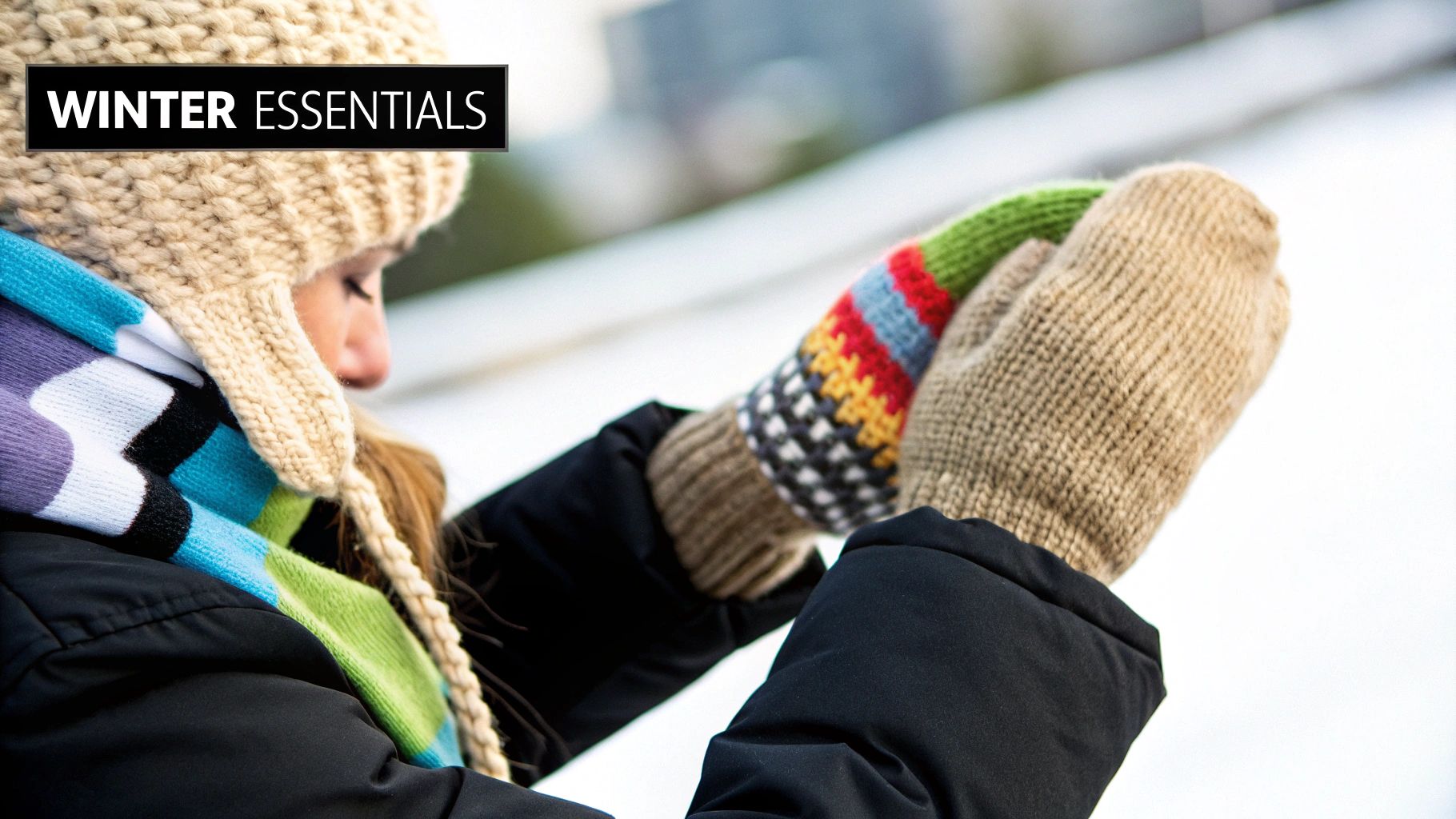
Getting dressed for a winter run is a world away from bundling up for a walk to the coffee shop. The real secret to staying comfortable in the cold isn't just piling on clothes; it's about knowing how to adjust those layers based on what you're doing. A one-size-fits-all approach is a recipe for disaster, leaving you either sweaty and overheated or, worse, dangerously chilled.
The core concept is pretty straightforward: your body generates a ton of heat when you're working hard. Your layering strategy has to shift from simply trapping heat to actively managing the sweat that comes with it. If you get this wrong, you'll end up soaked from the inside out, and the moment you stop moving, that moisture will make you freeze.
High-Intensity Activities: Snowshoeing, Skiing, or Running
When you're pushing your limits, breathability is everything. The main goal is to get moisture away from your skin as fast as possible.
- Base Layer: I always reach for a lightweight, synthetic top. While merino wool is great, I find high-performance synthetics dry much quicker, which is a lifesaver in high-sweat situations.
- Mid-Layer: Think light and airy. A thin, grid-style fleece or a lightly insulated vest is perfect. You need just enough insulation to take the edge off the cold without causing you to overheat two minutes in.
- Outer Layer: A breathable, waterproof shell with ventilation zips—often called pit zips—is non-negotiable. These are game-changers, letting you vent excess heat without having to stop and take off your entire jacket.
To keep your high-tech gear working season after season, it's worth learning the essential care tips for athletic wear and high-performance fabrics. Proper washing and drying ensure those moisture-wicking and protective qualities don't fade.
Low-Intensity Activities: Watching a Game or a Leisurely Walk
For more casual outings, your strategy flips entirely. Since your body isn't producing much of its own heat, your layers need to do all the work, trapping as much warmth as possible.
In this scenario, insulation is your best friend. You're building a fortress against the cold air, not managing your own body heat.
- Base Layer: A midweight merino wool base layer is ideal here, providing a soft, warm foundation that won't get clammy.
- Mid-Layer: This is where you bring out the big guns. A thick fleece, a puffy down jacket, or even a couple of stacked insulating layers will create that critical pocket of warm air around your core.
- Outer Layer: Look for a fully insulated and windproof jacket. Breathability takes a backseat to blocking the wind and holding in warmth.
The biggest mistake I see people make in low-intensity situations is underestimating how quickly the cold sinks in when you're standing still. It's always better to start with an extra layer you can shed than to be stuck shivering because you didn't bring enough.
This mindset of prioritizing warmth and being prepared is even more critical in extreme conditions. If you're planning an overnight trip, you'll find more advice in our guide on cold weather camping.
https://letsparty-au.myshopify.com/blogs/news/cold-weather-camping-tips
To give you a clearer picture, here’s how these strategies might look for different types of winter days.
Example Layering Strategies by Activity
| Activity Level | Base Layer Focus | Mid Layer Example | Outer Layer Focus |
|---|---|---|---|
| High (Trail Running) | Lightweight synthetic, maximum wicking | Thin grid fleece or wind vest | Highly breathable shell with pit zips |
| Moderate (Hiking) | Midweight merino wool or blend | Standard fleece or light synthetic puffy | Versatile shell with good breathability |
| Low (Ice Fishing) | Heavyweight merino wool | Thick down or synthetic puffy jacket | Heavily insulated, windproof parka |
Ultimately, tailoring your layers to your specific activity gives you complete control over your comfort. Once you master this, you can stay perfectly regulated no matter what the day—or the forecast—throws at you.
Common Cold Weather Clothing Mistakes to Avoid
Figuring out how to dress for the cold is usually a game of trial and error. We've all been there. But you can skip a lot of the shivering by learning from a few classic blunders. Getting your layering right is as much about what not to do as what to do.
Even with top-of-the-line gear, one wrong move can turn a great day into a miserable, teeth-chattering experience.
The "More is More" Myth
One of the biggest mistakes I see is simply piling on too many layers. It sounds backward, I know, but over-bundling is a fast track to getting cold. The second you start moving—whether it's hiking, shoveling snow, or just walking briskly—your body heats up and starts to sweat.
If that sweat gets trapped against your skin by fabrics that can't breathe, you're in trouble. That dampness will eventually make you feel much, much colder than you would have with fewer, smarter layers. It’s a vicious cycle. A bulky cotton sweater thrown over a t-shirt is a perfect example of this. It feels cozy for a minute, but it's an inefficient system that just traps moisture.
When Fashion Sabotages Warmth
Another all-too-common pitfall is choosing style over actual function, especially when it comes to your feet. Those stylish, thin boots might look fantastic, but if they have zero insulation, the cold ground will suck the warmth right out of your body. Once your feet get cold and damp, good luck warming anything else up.
Likewise, ignoring the material of your clothes is a recipe for a bad time. A trendy cotton hoodie might seem like a decent outer layer, but on a windy day, it's a huge mistake. The wind will cut right through that loose weave, making any insulating layers you have on underneath pretty much useless.
The whole point of layering is to create a personal microclimate that stays warm and dry. If one piece of your system traps sweat or lets the wind in, the entire thing fails. You’re left exposed, uncomfortable, and wanting to go back inside.
Forgetting The Little Things
It's easy to get so focused on your jacket and pants that you forget about the details. Neglecting to protect your head, hands, and face is a painful oversight. The sun's UV rays reflecting off snow can be incredibly intense, leading to a nasty sunburn on any exposed skin.
And don't forget the wind! It can chap your skin and make you feel ten degrees colder in an instant.
These seemingly small issues are often what separate an amazing winter day from one you have to cut short. The good news is that the winter apparel market is massive and full of fantastic, specialized gear to prevent these problems. In 2023, the global winter wear market was valued at roughly $343.9 billion, with coats and jackets alone accounting for over half of that.
With so many options out there, there's no excuse for settling for gear that doesn't work. You can dive deeper into the growth in winter apparel sales to see what's driving the market. By sidestepping these common mistakes, you can make sure your layers are actually working for you.
Your Cold Weather Clothing Questions, Answered
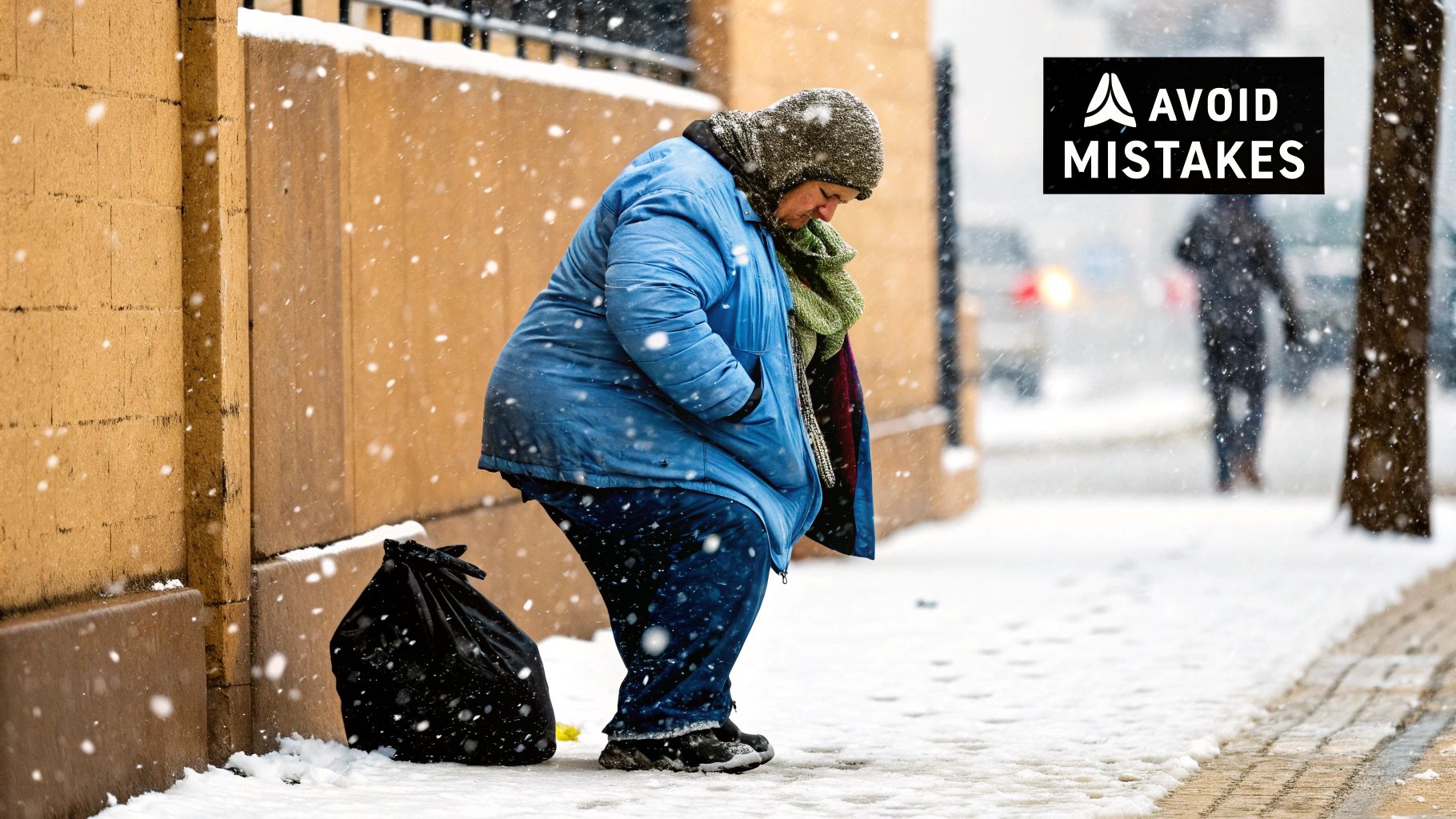
Even after you've got the basics down, a few tricky questions always seem to pop up when dressing for seriously cold weather. Getting these little details right is often what separates a genuinely comfortable day outside from a miserable one.
Let’s dig into some of the most common questions I hear. Nailing the specifics will give you the confidence to put together the perfect outfit for whatever winter throws your way.
Is Wool Always Better Than Synthetic Fabrics?
Not at all—it really comes down to what you’re doing.
Merino wool is my go-to base layer for most situations, especially for multi-day trips. It's fantastic at regulating temperature and naturally resists odor, which is a huge plus. It also keeps you warm even when it gets a little damp.
But if I'm doing something high-intensity, like winter running or skinning up a mountain, high-performance synthetics are king. They pull moisture away from your skin much faster, which is critical for avoiding a post-sweat chill. Synthetic fleece also makes for a great, quick-drying mid-layer.
The best strategy is often to mix them. I might wear a wool base layer for a long day of hiking and throw on a synthetic fleece vest over it to manage sweat when the trail gets steep.
How Do I Stay Warm Without Looking So Bulky?
This is the eternal struggle, isn't it? The secret is choosing modern, efficient materials. It’s all about quality over quantity. Smart layering with high-tech pieces will always beat piling on chunky, old-school sweaters.
Here’s the game plan for staying warm and streamlined:
- Start with a slim base. A thin merino wool or even a silk long-sleeved tee adds a surprising amount of warmth with zero bulk.
- Insulate intelligently. Look for mid-layers with high-fill-power down (think 800-fill or higher). This stuff packs an incredible amount of warmth for its weight. The same goes for modern synthetic insulations, which are designed to be low-profile.
- Get a modern shell. A well-fitted, technical shell jacket provides a ton of wind and water protection without adding much size. They're built for movement, not for puffiness.
By focusing on these advanced fabrics, you can build a seriously powerful thermal barrier that doesn’t leave you feeling like the Michelin Man.
A huge mistake people make is thinking thicker always means warmer. The truth is, the efficiency of the insulation is what counts. A thin, high-fill-power down vest is often warmer than a fleece jacket twice its thickness.
What Is the Single Most Important Piece of Winter Gear?
If I had to tell you where to put your money, it would be a dead heat between two items: a high-quality outer layer (your shell jacket) and a pair of waterproof, insulated boots. These are the absolute cornerstones of any good winter setup.
Your jacket is your shield. It's your first line of defense against the wind and moisture that steal your body heat the fastest. It keeps your other layers dry so they can actually do their job of insulating you.
And your feet? Once they get cold and wet, it's game over. It becomes nearly impossible to warm up the rest of your body. Your boots are what separate you from the frozen ground, so keeping them dry and toasty is non-negotiable for both comfort and safety.
At FindTopTrends, we curate the best in trending gear and apparel to keep you comfortable and stylish in any season. Explore our collections to find the perfect pieces for your winter adventures. Find what you need at https://findtoptrends.com.






